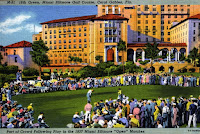 |
Downtown Fort Lauderdale circa 1950
Florida State Archives/Florida Memory |
By Jane Feehan
Many remember the big department stores in Fort Lauderdale, but
some smaller stores and businesses listed below may have fallen from memory. A
quick and incomplete survey of where Fort Lauderdale shopped in
December-March of 1950, and December of 1960 and 1970 indicates a shift from the
smaller family-run businesses to the larger, more ubiquitous department stores. The
chain stores gained in popularity when they migrated from shopping districts to
shopping centers or plazas.
Also listed are a few car dealerships and other businesses
whose owners gained wide recognition because of signature advertising or other well-known
pursuits. Complete addresses are included where they could be found. Note – these
businesses serve as a snapshot in each of the years mentioned. Other businesses that
some may remember but are not on this list may have operated later in the
decade. Again, the list is incomplete (of course there was/is Publix, Winn Dixie, etc.)
 |
Las Olas Boulevard circa 1980
Florida State Archives/Florida Memory |
December-March 1950
Belk-Lindsey – (department stores) 108 S.
Andrews
Bunning the Florist – South Andrews
Burdines Department Store on Andrews Avenue.
Causeway Lumber – 2701 S. Andrews Avenue
Chemist Shop – 817 E. Las Olas Boulevard
David Leonard Shoes – 716 E. Las Olas Boulevard
Duval Jewelry – 208 S. Andrews Avenue
Fort Lauderdale Lincoln Mercury - 501 S. Federal
Highway
Gill Construction Company – 105 E. Las Olas
Boulevard (and later hotels)
Holsum Bakery – “Home-town bakers for 37 years”
Jordan Marsh – Sunrise Shopping Center
King Oldsmobile - Sunrise Boulevard
Lauderdale Shoe Store – 224 S. Andrews Avenue
Lovett’s Food Stores – 220 N. Federal Highway
McFarlenes – (televisions) – 300 East Las Olas
Boulevard
Ray Allen (men’s and boy’s fashion) – 114 E. Las
Olas Boulevard
R.H. Gore Orchids – 1611 SW 9th Avenue
Rhode’s Furniture – 203 SW First Avenue
Saks Fifth Avenue – Sunrise Shopping Center
Scott’s (fashion) – Andrews and 2nd Avenue
Sears on Andrews Avenue
Smith’s Boulevard Pharmacy - 607 E. Las Olas
Boulevard
Thomas F. Gustafson - Painting and Decorating, Interior-Exterior
– 822 SW 17th Street
Watty & Son (jewelry) – 1225 E. Las Olas Boulevard
Wellens Furniture – 223 SW First Avenue
December 1960
Belk Lindsey – South Andrews Avenue
Bird Camera Shop – 617 E. Broward Boulevard
Browning King & Co. – “Attire that is tailored
to suit millionaires” - 442 E. Las Olas Boulevard
Burdines – Sunrise Shopping Center
Carl’s Furniture – 808 W. Broward Boulevard
Castro Convertibles – N. Federal Highway
Dart Drugs – 114 S. Andrews Avenue
Goody Shoes – W. Broward Boulevard
Hale Piano – S. Andrews Avenue
Helmly’s – furniture and appliances – 419 S. Andrews
Avenue
Ivy Shop – men’s fashion – 7 S. Andrews Avenue
Jefferson Department Stores– N. Federal Highway
Jordan Marsh – Sunrise Shopping Center
Mangurian’s - (furniture) – 3700 N. Federal Hwy
ModernAge (furniture) – Federal Highway
Pan-American Tire Co. – 3010 S. Federal Highway
Pullman’s Furniture - 738 N. Federal Highway
Saks Fifth Avenue – Sunrise Shopping Center
Sears at Searstown, Federal and Sunrise
Sterling’s (fashion for men and boys) – 27 Wall
Street
Miller’s Jewelers – 201 SE First Avenue
Overbrook Music - 1001 E. Sunrise Boulevard
December 1970
Associated Carpets – 3991 N. Federal Highway
Bill Binko Chrysler Plymouth – 1750 N. Federal
Highway
Burdines – Sunrise Shopping Center
Britts – Coral Ridge Shopping Center
Discount Land – furniture – 4000 N. Federal Highway
Dutch’s Appliances – 2930 N. Federal Highway
Jefferson Super Store - Federal Highway
Jordan Marsh – Sunrise Shopping Center
K-Mart – Oakland Park Boulevard
Levitz Furniture – Powerline and NW 12th
Street
Massy-Yardley Dodge – 1600 M. Federal
Highway (today in Plantation)
Penny’s – Coral Ridge Shopping Center
Sears at Searstown – Federal and Sunrise
Zayre – Broward Boulevard
 |
Saks Fifth Avenue 1955 - Fort Lauderdale
Florida State Archives/Florida Memory
|
For more retail history, see index for "Fort Lauderdale retail history"
Sources:
Fort Lauderdale News, Feb. 4, 1950
Fort Lauderdale News. March 3, 1950
Fort Lauderdale News, Dec. 11, 1960
Fort Lauderdale News, Dec.
12, 1970
Tags: Fort Lauderdale history, History of Fort Lauderdale, About Fort Lauderdale





































